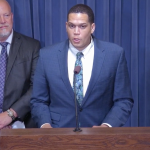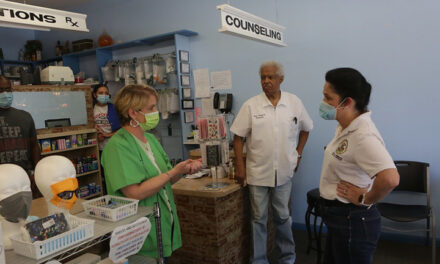
On the record with Karen Teitelbaum, CEO, Sinai Health System

Sinai Health System has much to celebrate as it turns 100, according to CEO Karen Teitelbaum.
She said the system continues to expand services despite being “Chicago’s largest safety net” and operating in the city’s underserved communities. That includes a new crisis stabilization unit at Holy Cross Hospital that she calls the first of its kind in Chicago.
Teitelbaum recently spoke with Health News Illinois about hitting the century mark, what more policymakers can do to help safety nets and whether a merger is in Sinai’s future.
Edited excerpts are below:
HNI: How will the new crisis stabilization unit at Holy Cross Hospital impact patients in the area? Why did you move forward with this project?
KT: Since we’re one of the largest providers of health services in Chicago, we recently put in about $10 million for the development of inpatient, outpatient and crisis stabilization services. Particularly on the southwest side of Chicago, behavioral health for government-insured patients is not always seen as a profitable service line. If it were, we’d have a lot more access points for this population that is so in need of behavioral health services. So over the last, I’d say, eight years or so, many facilities closed their doors despite there being a growing need for behavioral health services. Sinai went the opposite way. With the Affordable Care Act, it now provides us with additional dollars from insuring people who were not insured before. We took that money and invested it in behavioral health. So our new crisis stabilization unit, which is the first in Chicago, opened officially on July 10 at Holy Cross Hospital on the southwest side of Chicago. It’s been kind of a desert for behavioral health. We are the only hospital in a five-mile radius and there were absolutely no behavioral health services from a hospital-based perspective, whether ambulatory or inpatient, until we developed those services.
People get their treatment, they’re observed until we determine that they would be safe, and then we discharge people with appropriate medication and a discharge plan in mind. We’re not just discharging people back into the street. We’re making sure they are safe and with follow-up appointments. So even though our full unit opened just last month in July, a few years ago we started a pilot program to see how this would go. And in four years we have actually served more than 5,000 patients. And here’s the great thing: About 70 percent were stabilized and discharged to lower levels of care for referrals as opposed to being seen in an expansive, chaotic emergency room. So we feel pretty good about that. Now the hospital is, of course, where we make money. We make money on inpatient admission. So even though it might hurt us financially, Sinai is doing what we’ve always done: the right thing in terms of how we keep patients healthy in this community. That is always our focus.
And I guess the other interesting thing about this is, even though it is like a traditional emergency room, the new CSU has a designated area for emergency personnel and we’ve partnered very closely with police, paramedics, the Cook County sheriff and his staff. It also offers walk-in access for individuals to get assessed and to get treated. So it’s really a wonderful alternative when people are in their most vulnerable episodes of their lives.
HNI: Sinai also recently opened a short-stay observation unit at Mount Sinai Hospital. Tell us more about that project.
KT: Usually, you got people coming in who perhaps are really only in observation status, which means that they’re in for two days. They do not need long-term hospitalization. So if someone obviously needs to just be observed after an episode of care of an episode of illness, it’s not as intense a level of care that you would need for an admission. And what we found was that in order to give our patients and our community the appropriate amount of care, we decided to do this pilot in terms of grouping together, in one area, observation patients. So we staff it a little differently, because it is a lower level of care that is needed, or else people would be on a regular unit. And it allows us to do protocols that are much more appropriate for that level of care, like a step down from a true hospital admission. So we’re getting people the appropriate level of care in a safe environment, and we’re being a good steward of resources with the staffing patterns and how we have the care management arranged.
HNI: Sinai closed Touhy Health Center last year, citing a drop in refugee patients due to federal policies, and shifted that care to Antillas Family Medical Center. How has that transition gone so far and is it delivering the expected savings?
KT: I’ll say yes, but it’s not only the expected savings. To me the whole point was, as Chicago’s largest safety net, we have to stay viable. We have to be good stewards of our resources so we can be here for another 100 years to serve these vulnerable communities. So when we saw the dramatic drop after 2016 and the changes in federal policies where immigration is concerned, we really put our heads together. Not only with our clinical people, transportation folks, but more importantly with the community partners that serve the immigrant community. They depend on us to provide these culturally sensitive, culturally competent screenings. You can imagine how complex this is, not only language, but cultures unique for different services. So together we were able to come up with an alternative to a sole-standing clinic for the refugees. And this actually worked out far better than I ever would have thought, to our delight, to put these clinics with an existing medical clinic. And we did it in a spot that has access to public transportation.
You think of trying to make your way after what had to have been a traumatic voyage or journey to come to a new country. Most of our refugee patients do not speak the language. And can you imagine trying to figure out where to go? So we had our new clinic. It is in an existing clinic that is very convenient for public transportation. We were able to maintain our providers who had been at the heart of this clinic. We really have been doing this for a decade now and understand how best to work with and engage the immigrant community. And the thing that’s a little bit different is because it’s in an existing clinic, we now have a collocation of a number of different services that we might not have had before. So that makes it ever so much more convenient for our coordination of care for a very challenged population.
HNI: As a safety net provider, what are other specific challenges do you face?
KT: Well, we are about 60 percent Medicaid and another 20 percent Medicare. And then we have about 7 to 8 percent that are no-pay. That kind of speaks for itself. One challenge, of course, is cash flow. And one big change in Illinois that impacted both Sinai and all of the safety net hospitals was to move from Medicaid managed by the state to Medicaid managed by managed care organizations. When that occurred in 2014 or so we saw, as did everyone else, slow payments and higher-than-expected denial rates from the managed care organizations for care that we had already delivered that was high quality and medically necessary. For hospitals that have a different kind of payer mix, they can weather that kind of slowdown. For us and other safety nets, it can turn into a real life-or-death situation.
So what happens with Sinai is exacerbated because we are much more complex than many other safety net providers. We’re bigger. We’re a teaching hospital, which we always have been for 100 years. We operate a level 1 trauma center because that’s what our community needs. We have three times the homicide rate in North Lawndale than we do in the rest of the city. We provide level 3, the highest level of care, for our neonatal intensive care unit. Our smallest baby was 12 ounces. You really start to see how complex this is. We just provide an array of programs and services that are critically needed for the community’s benefit, but that also requires substantial financial support. So to make all of that possible, we depend on timely and complete payments for the services that we give.
So in the past year, year and a half, we’ve reached out to each of the managed care organizations to address those payment issues, to see how we could work more closely together for the benefit of the enrollees. We’ve also supported the Illinois Health and Hospital Association, who were big proponents for addressing timely payments and addressing high denial rates. And Gov. Pritzker and members of the General Assembly just passed the legislation this past spring that ensures accountability and more timely payments for those services for all the safety nets like Sinai where it’s so critical.
HNI: What more can policymakers do to help safety net hospitals?
KT: I think that one thing is to really take a look at how healthcare gets reimbursed and maybe reimagine how that works. Right now, where do we make our money as a hospital system? Mainly where people get high-end procedures and are admitted to the hospital, that is where the bigger margin is. But what do we all want to do? We all want to get people healthy and out of the hospital. So right there we have these competing incentives. And likewise with physicians, they get paid more for providing complex care and seeing their patients. So I would love to partner with the state, with the city and certainly federal to turn that reimbursement model on its head so we are actually getting reimbursed for keeping people healthy. And of course there’s value-based purchasing and you get rewarded for certain health-related incentive outcomes. For hospitals like safety nets, that’s not quite enough. We need a wholesale change because we don’t always have contacts that support that type of care. I’m getting a little into the weeds here, but I think the big takeaway is let’s change the reimbursement model to really pay for keeping people out of the hospital and everybody wins.
HNI: Other health systems of Sinai’s size are increasingly facing pressure to partner with larger systems. How has Sinai been able to remain independent?
KT: I think there are a couple of reasons. When you look at our bottom line as a safety net, that is always a challenge. You look at who has been partnering up, and by and large, it hasn’t been safety nets with limited cash on hand…I think safety nets in large are going to be partnering in different ways than the mergers and acquisitions that you traditionally see in Chicago and across Illinois.
HNI: Do you anticipate that Sinai will merge or partner with a larger system in the near future?
KT: We are totally open to anything that allows us to continue to grow and thrive, to continue to stay true to our mission and that will improve the health of the community and that will allow us to be good stewards of very, very scarce resources. We always keep an open mind about everything. If you had told me 10 years ago we’d be bringing on another safety net, and a Catholic safety net… I would have said that was crazy. But of course we brought on Holy Cross, and it’s worked beautifully. I feel Sinai is better for having expanded our service area and by adding Holy Cross, which is a wonderful hospital.
HNI: Sinai is celebrating its 100th anniversary this year and part of that celebration is the Campaign for 100. Can you tell me more about that endeavor?
KT: So the Campaign for 100, it was a campaign that focused on capital needs. We are just amazingly fortunate to have, we had a matching grant on that, a challenge grant from a wonderful family that could invest anywhere but they want to invest in urban healthcare in Chicago so they can make an immediate difference. So the goal was pretty modest. It was $750,000. To date, and we’re not done yet, we’ve raised $1.3 million through philanthropy. And that enabled us to… we always have whatever we need for safety and quality, but being able to have these dollars immediately available and to fast track getting additional equipment to expand the services that we provide.
We look at what our community needs are. For example, we know there is a continuing infant mortality and morbidity issue in our community. So what do we want to do? We want to expand the care through our neonatal intensive care unit, our emergency department, for those that need us. One category was additional baby warmers because we know that’s an area that’s expanding. So we look at where the needs are expanding and that’s the first place we put the equipment.
Health News Illinois is a nonpartisan, independent news service covering the Illinois healthcare beat. Sign up for a free trial to the newsletter here.









